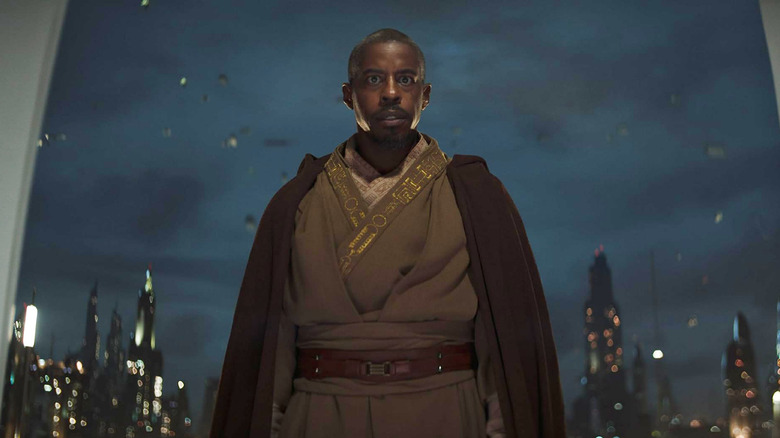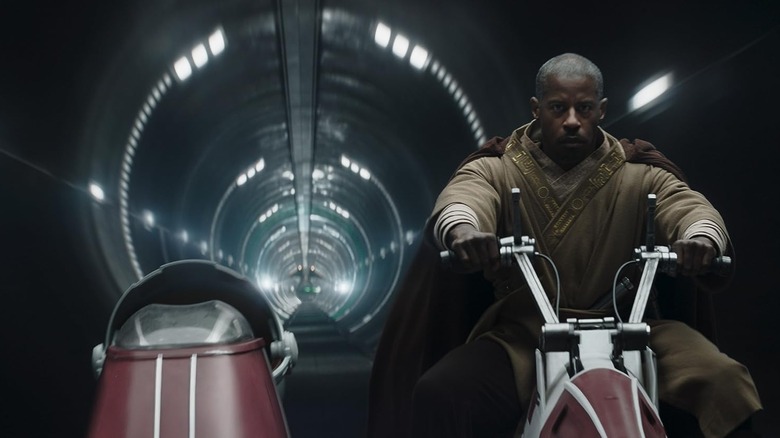How The Mandalorian Used Ahmed Best's Tattoos To Reinvent Kelleran Beq's Jedi Robe
"You either die a hero, or you live long enough to see yourself become the villain," Harvey Dent (Aaron Eckhart) declares in "The Dark Knight." Well, when it comes to George Lucas' "Star Wars" prequel trilogy, it's the opposite. In an era of cookie-cutter tentpoles that refuse to take risks or say anything meaningful about the real world, many "Star Wars" fans have formed a newfound (if somewhat begrudging) respect for Lucas' idiosyncratic prequel films. That reappraisal extends to those who acted in Lucas' films, perhaps none more so than Jar Jar Binks performer Ahmed Best.
As with his "Phantom Menace" co-star Jake Lloyd, Best was the target of much-undeserved scorn for his work on the prequels. It's why it's been so rejuvenating to see "Star Wars" fans embrace Best as he takes a second go at the franchise playing the Jedi Master Kelleran Beq. Having started out as the host of the children's game web series "Star Wars: Jedi Temple Challenge," Beq is now a key part of the franchise's mythology thanks to "The Mandalorian," which has revealed him as the mysterious warrior who rescued Din Grogu during Order 66.
Whereas Beq wears a plain beige Jedi tunic and brown robes in "Jedi Temple Challenge," showrunner Jon Favreau and costume designer Shawna Trpcic wanted to give his attire a snazzy upgrade for "The Mandalorian." According to Variety, Favreau and Trpcic mined inspiration from the designs of real-life Jewish temples and the scrollwork on the shawls worn by their highest-ranking rabbis. "That was my takeaway. What set him apart was different scrollwork," said Trpcic. "I sketched some out for him. I looked at other Jedi to see what their different leather pieces were." However, as it turns out, Best himself was also a key influence on the character's re-imagined outfit.
A teacher first
You can plainly see the scrollwork on Beq's clothing in "The Mandalorian," based in part on Best's own tattoos. "He had all this glorious art, and once he got into the story of it, I did my own research," said Trpcic. "We incorporated an Afro-futuristic version of that tattoo work into his Jedi robes, which completed his story of redemption from his own walk in life. I got to reinvent a Jedi robe."
It's not just his fashion sense that sets Beq apart from other Jedi. When Best was figuring out the character for "Jedi Temple Challenge," he locked onto the idea of him being a teacher first, a warrior second. "This is the first Jedi that we've seen that is dedicated to just teaching," Best told StarWars.com in 2020. "And I wanted to pay homage to some Jedi of the past. There's a mentorship that Obi-Wan Kenobi has and that Yoda has that are very much a nurturing kind of mentorship and I wanted to see if I could capture that nurturing sense." Thankfully, "The Mandalorian" doesn't undermine this idea. Instead, it only affirms it by making Beq a hero who risks his own life and limb to save someone else.
Clearly, everyone involved put a lot of thought and consideration into Best's return to a galaxy far, far away, not least of all the actor himself. It wasn't something he took lightly. Best has been incredibly open about the terrible impact the initial reactions to Jar Jar Binks had on him and his mental health, spurring him to contemplate suicide at one point. To see him welcomed back to "Star Wars" with open arms years later, well, it's enough to fill you with the type of hope that "Star Wars" has always championed.

